The Meizu M3 Note vs. Xiaomi Redmi Note 3 Review: Comparing Notes
by Matt Humrick on July 12, 2016 8:00 AM EST- Posted in
- Smartphones
- Mobile
- Xiaomi
- Meizu
- Redmi
Battery Life
Battery life is very difficult to quantify because there are so many variables in play. The different apps people use, which ones are running in the background, what networks the phone is connected to, and the signal strength of those networks are just a few examples of why battery life differs from one person to the next. Our battery life tests mimic a few common workloads while controlling as many of these variables as possible, which includes calibrating each display to 200 nits at 100% APL. They are not meant to tell you how long a phone will last during a typical day for you. Instead, they are designed to fairly compare the runtime potential of one phone to another.
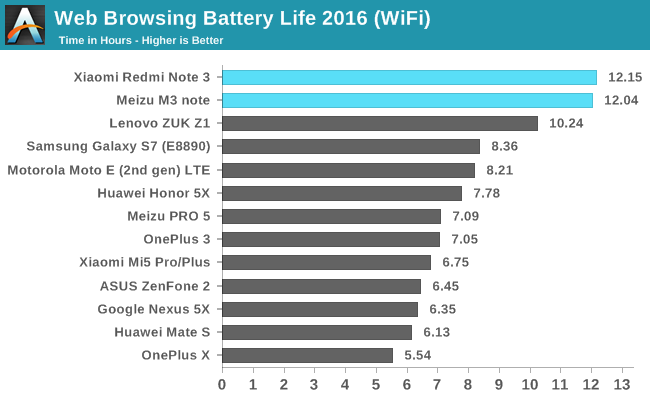
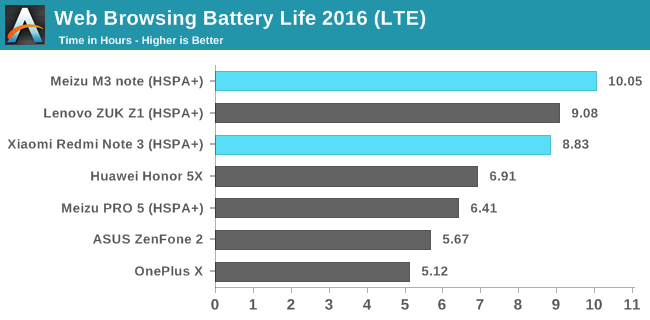
Our new browsing tests are more realistic, making better use of the CPU by pausing and then scrolling through each page. When browsing over Wi-Fi, both the Meizu M3 note and Xiaomi Redmi Note 3 make good use of their larger than 4000mAh batteries to last for an impressive 12 hours, more than 4 hours longer than the Huawei Honor 5X and its 3000mAh battery. A rough calculation gives the Redmi Note 3 an average platform power (APP) of 1.28W, a little less than the Honor 5X at 1.47W and the Mate S at 1.75W.
Several of the devices we’re comparing do not support US LTE frequency bands, so they are using WCDMA/HSPA+ instead, as noted in the above chart. The M3 note lasts the longest here—an impressive 10 hours. Both the ZUK Z1 (which also has a 4100mAh battery like the M3 note) and Redmi Note 3 are not far behind at 9 hours. Comparing APP, the M3 note does better than the Redmi Note 3 when using its cellular radio but the difference is small, with the M3 note, Honor 5X, and Redmi Note 3 falling between 1.6W to 1.8W, in that order.
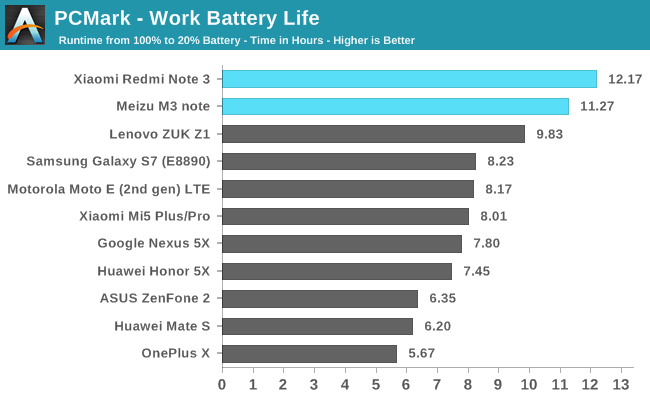
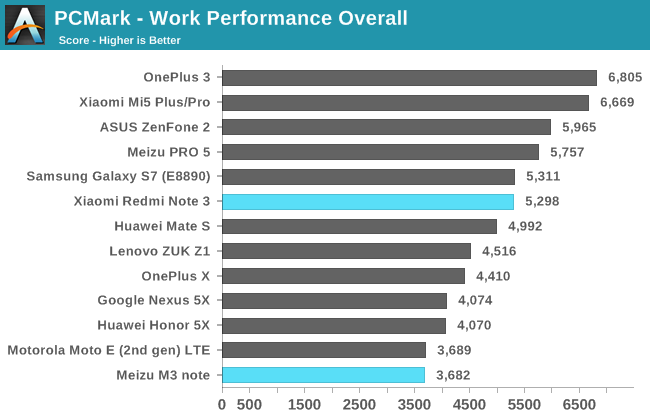
Both the M3 note and Redmi Note 3 last a long time while running PCMark’s realistic workloads, outlasting even the Huawei Mate 8 and ZUK Z1 that both reach 9.83 hours. The Redmi Note 3 stands out, however, because it lasts over 12 hours while still delivering better performance than its peers. For example, it outperforms the Honor 5X by 30% overall and lasts 4.7 hours longer. The Mate S delivers similar performance to the Redmi Note 3, even outperforming the Note in specific tests, but its smaller battery helps cut runtime in almost half relative to the Note. The Redmi Note 3 also matches the average PCMark performance of the Galaxy S7 (Exynos 8890) and still lasts 4 hours longer.
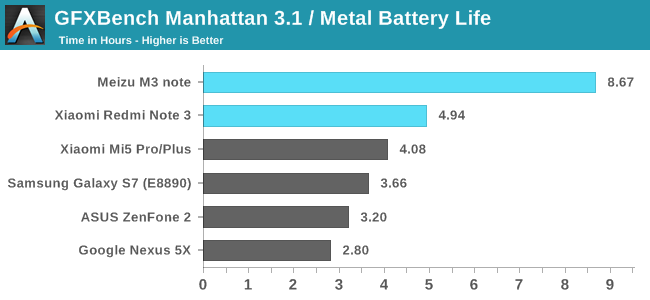
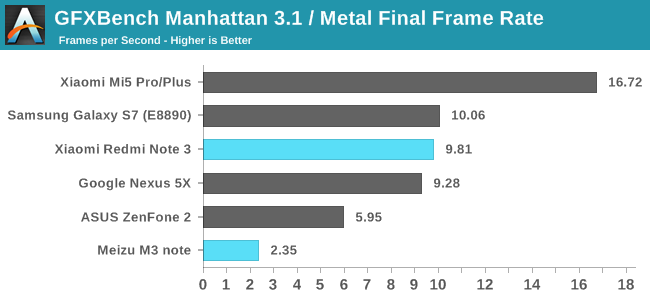
The GFXBench Manhattan 3.1 battery life test stresses the GPU, providing an estimate for both a device’s runtime while playing games and its frame rate stability. As noted in the previous section on GPU performance, not all of the phones we’re comparing in this roundup are capable of running this OpenGL ES 3.1 game simulation, which is why there are so few devices in these charts.
The M3 note lasts more than 8.5 hours, which is the longest for any phone we’ve tested to date. This result is tempered, however, by its rather poor performance. In the previous section, we concluded that the M3 note’s low-power GPU is only suitable for casual gaming after performing poorly in our test suite and failing to deliver playable frame rates in some 3D games. There is some good news, however: If you only play games like “Angry Birds” or “Words With Friends,” you can play them for a very long time.
The Galaxy S7’s (Exynos 8890) peak performance is about 50% higher than the Redmi Note 3’s, but their sustained onscreen performance is essentially the same after heat forces the S7 to throttle back after 20-25 minutes (the S7 renders onscreen at 1440p vs. 1080p for the Redmi Note 3, so the S7 is still doing more work). The Redmi Note 3 is like a long-distance runner, maintaining an even pace and outlasting the initially faster Galaxy S7 (Exynos 8890) by 1.25 hours. While not shown in the chart above, the more-expensive Galaxy S7 edge (Snapdragon 820) and Huawei Mate 8 have bigger batteries than the Galaxy S7, giving them a runtime on par with the Redmi Note 3 at the same sustained performance. Only Xiaomi’s Mi5 Pro (also with a 1080p LCD display) maintains a higher level of performance over the duration of the test while lasting almost as long as the Redmi Note 3.
The GFXBench Manhattan 3.1 performance stability graphs look pleasantly boring. Both the M3 note and Redmi Note 3 avoid thermal throttling, maintaining the same level of onscreen graphics performance until they run out of battery power. The Redmi Note 3 gets warm but not hot, while the M3 note remains cool to the touch.
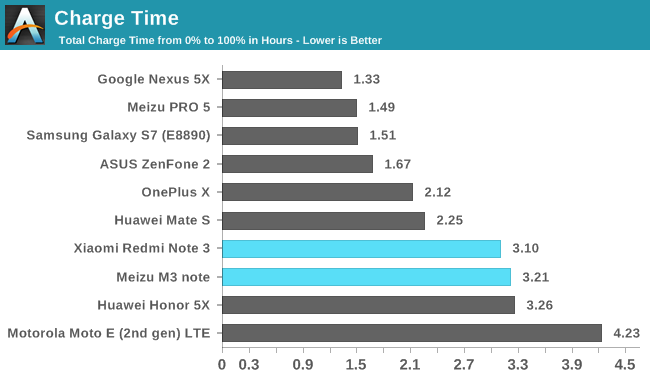
Both phones come with 10W chargers (5V at 2A) that are capable of fully charging their large batteries in just over 3 hours. Despite its 25% smaller battery, the Honor 5X takes just as long to charge, because it comes with only a 5W charger.
The M3 note and Redmi Note 3 have excellent battery life according to our tests. The M3 note lasts just as long or a little longer than the Redmi Note 3, but its SoC does not deliver the same level of performance.
Audio Quality
Smartphone audio quality has been on the rise the past few years. While external speakers still show significant variation in sound quality, headphone output has become consistently good, at least among mid-range and flagship phones. There’s even a few, like the Meizu PRO 5 we previously reviewed, that really sound excellent. Has any of this audio technology found its way into lower-cost devices yet?
The M3 note has a single downward-firing speaker sitting behind the series of holes on the right. It gets reasonably loud, but the volume control is nonlinear, so it needs to be turned up almost all the way before it becomes audible across a room or inside a pocket. The sound is very tinny without much contribution from lower frequencies. It’s difficult to hear softer background instruments when listening to music, with sounds blurring together into a cacophony of noise. The M3 note’s speaker is best suited for basic ringtone duty, and even then you have to turn the volume way up.
The Redmi Note 3’s mono speaker is on the back of the phone. Because its sound is aimed away from your ears, you have to cup your hand behind the phone or place it in front of a hard surface to reflect the sound back towards you. This becomes a problem, however, when the phone is resting on a surface with the screen facing up. The back of the Redmi Note 3 is flat, which means the speaker is nearly flush with the surface underneath. A small bump, which sits just below the speaker, is meant to lift the phone slightly to give the speaker some breathing room; however, it’s not enough. Setting the phone on a wood table muffles the sound and degrades quality. Placing it on a softer surface, such as a leather chair, chokes the sound almost completely.
Giving the Redmi Note 3’s speaker some room to work yields decent results, definitely better than the M3 note. The speaker sounds better with a hand cupped behind the phone, producing a fuller sound without the faint background hiss that’s present when listening to music directly from the speaker. There’s more lower-frequency content than the M3 note, and voices sound distinct and pretty clear. The speaker also gets loud enough to hear in most situations.
The first thing I noticed when plugging a set of headphones into the Redmi Note 3 was that it gets very loud. After resetting the volume to a more sensible level, I found its sound quality to be decent but not quite as good as the iPhone 6s I was using as a reference. Everything was fine until the music got too complex, with many different sounds layered together, at which point I noticed a subtle lack of clarity and a deficit in depth and separation. Diving into the settings menu, I enabled the “Mi Sound Enhancer” and adjusted the EQ, which fixed the initial problems I heard. Based on my subjective results, I’d say the Redmi Note 3’s hardware is pretty close to what’s in the iPhone 6s, but requires some extra effort fiddling with the software to get the most from it.
The M3 note’s headphone amplifier does not have the same output power as the Redmi Note 3 or iPhone 6s reference. It’s capable of driving low-impedance headphones to sufficient volume levels, but is not capable of driving higher-impedance loads. Sound quality is nothing special either, clearly falling below the iPhone 6s and Redmi Note 3. As is typical for a lower-powered amplifier, it sounds a bit dull and lifeless, with limited dynamic range. The sound is not horrible, though; less-critical listeners using a typical set of earbuds will likely find the M3 note’s sound to be good enough. This does show that audio quality remains a point of differentiation at this price point.



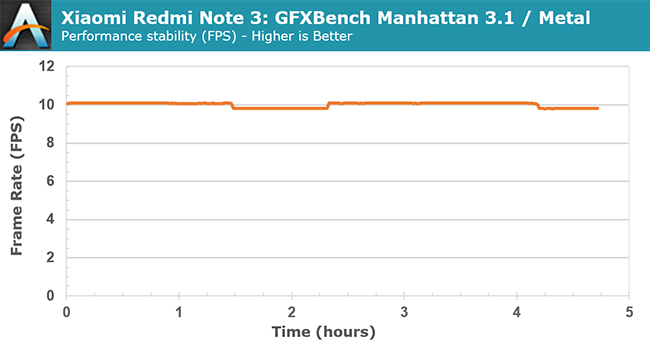
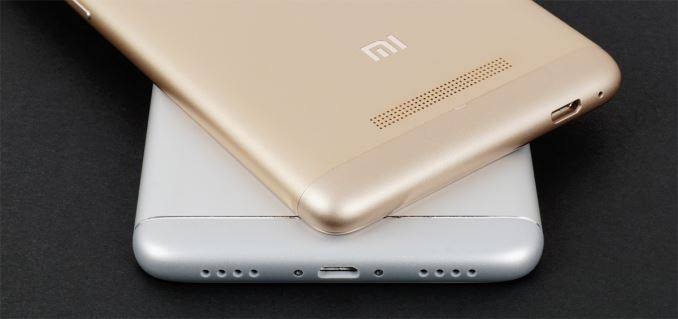








79 Comments
View All Comments
jospoortvliet - Wednesday, July 13, 2016 - link
Yeah, I appreciate the real life benchmarks but the software can be fixed, the hardware can not so it would be good to know where the potential of the phone lies. The measurement of the read and write speeds are very helpful in this regards but a more synthetic test would be nice, honestly I don't trust something like PCMARK at all.jospoortvliet - Wednesday, July 13, 2016 - link
I mean, "writing", "video", what are those supposed to test? Performance while writing get or playing video? Who cares, what phone has rouble with either of those tasks, a 2005 phone was fast enough...John Bens - Tuesday, July 12, 2016 - link
Nice comparison. Geekbuying actually has the M3 Note on sale at $152.99 which is a pretty good deal.Geranium - Tuesday, July 12, 2016 - link
Good phones. But as a Chinese phore there are two problems as usuali. UI
ii. Software update.
Are Chinese phone manufacturers shameless? Instead following Android design language they copy iOS design and feel good for it.
yoghibawono - Wednesday, July 13, 2016 - link
they dont try to copy. They follow what the majority of their country likes. Since early 2005 I believe even HTC and Huawei dont use any app drawer. And the fact that their UI is more user friendly, vast themes, feature-rich. Even if their base is kitkat; look whose first implementing permission manager? these chinese UI. Integrated backup-restore etc etc.Impulses - Thursday, July 14, 2016 - link
Uh, pretty sure HTC has an app drawer...aryonoco - Tuesday, July 12, 2016 - link
Thanks for the review Matt, much appreciated.Also thanks for the LTE bands support table. This is something that I've argued should be present in all reviews, and it's great to see it so prominently and clearly laid out.
In future, can I ask Anandtech to also focus on the Android Security Level that a phone runs? I find it increasingly disturbing that OEMs are ignoring Google's monthly security patches. One review of recent security bulletin shows that each month they are fixing serious vulnerabilities, some of them being kernel-level vulnerabilities with remote exploit capabilities. In my opinion it is irresponsible, borderline unethical for a manufacturer to release a handset with known remote root exploits and then fail to patch it.
It is one thing for an OEM to change the UI the way MIUI does, at the end of the day, these are matters of preference and taste. It is even acceptable in my view not to update the Android OS due to business/technical reasons. But not patching security vulnerabilities? That should not be acceptable. We need manufacturers to at least commit to supporting their handsets for the duration of their lifetime (whether that's two years or three years or whatever) with security patches. And we need to call out and name and shame those who don't. Frankly if websites such as AT don't do this, I don't know who will.
Let's put it this way, if say Windows 8 or Windows 10 had a remote exploit vulnerability, and yet a laptop running the said OS didn't get this vulnerability fixed in a reasonable amount of time (for whatever reason), AT and the whole tech media would be up in arms. At the end of the day, I don't care whether it's Google's fault or the SoC vendor's fault or the OEM's fault or the carrier's fault, these are contractual details and they can sort it out between themselves. The customer pays money to an OEM (or a carrier) and the customer's contractual agreement is with them. We need to call out this situation, hold the OEM, the carrier, Google and the whole ecosystem to account. As smartphones move ever more closer to becoming general purpose computers, and they hold vast amounts of our personal information, this situation is unacceptable.
abcdravi - Wednesday, July 13, 2016 - link
I agree.Pissedoffyouth - Wednesday, July 13, 2016 - link
XIaomi are very good at patching security updates from what I've foundaryonoco - Wednesday, July 13, 2016 - link
Great! So when you go to software info or about device (or whatever Xiaomi is calling it) you can see the Android security patch level? And they are mostly up to date? If this is true, it would make Xiaomi phones a hugely more appealing purchase in my opinion.And I think it would be great if a website as thorough as AT paid attention to this, and called it out.